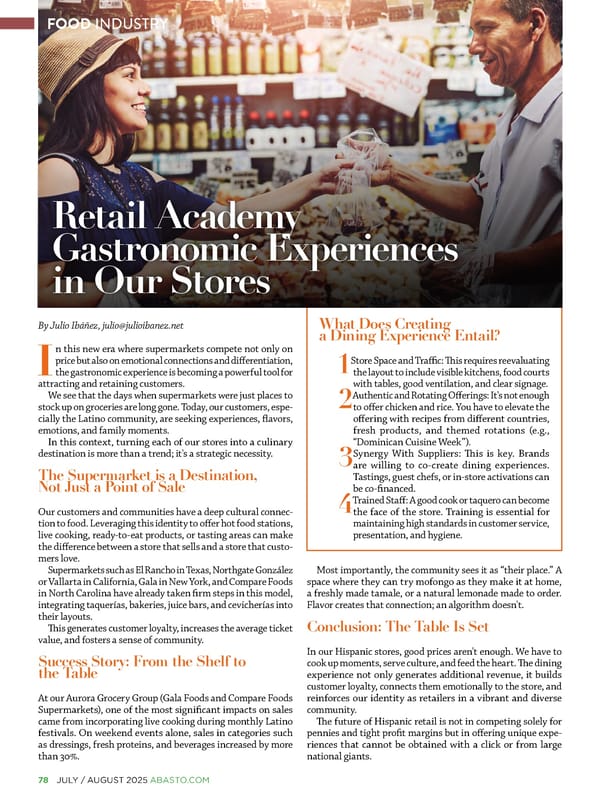78 JULY / AUGUST 2025 ABASTO.COM By Julio Ibáñez, [email protected] I n this new era where supermarkets compete not only on price but also on emotional connections and differentiation, the gastronomic experience is becoming a powerful tool for attracting and retaining customers. We see that the days when supermarkets were just places to stock up on groceries are long gone. Today, our customers, espe- cially the Latino community, are seeking experiences, flavors, emotions, and family moments. In this context, turning each of our stores into a culinary destination is more than a trend; it's a strategic necessity. The Supermarket is a Destination, Not Just a Point of Sale Our customers and communities have a deep cultural connec- tion to food. Leveraging this identity to offer hot food stations, live cooking, ready-to-eat products, or tasting areas can make the difference between a store that sells and a store that custo- mers love. Supermarkets such as El Rancho in Texas, Northgate González or Vallarta in California, Gala in New York, and Compare Foods in North Carolina have already taken firm steps in this model, integrating taquerías, bakeries, juice bars, and cevicherías into their layouts. This generates customer loyalty, increases the average ticket value, and fosters a sense of community. Success Story: From the Shelf to the Table At our Aurora Grocery Group (Gala Foods and Compare Foods Supermarkets), one of the most significant impacts on sales came from incorporating live cooking during monthly Latino festivals. On weekend events alone, sales in categories such as dressings, fresh proteins, and beverages increased by more than 30%. What Does Creating a Dining Experience Entail? 1 Store Space and Traffic: This requires reevaluating the layout to include visible kitchens, food courts with tables, good ventilation, and clear signage. 2 Authentic and Rotating Offerings: It's not enough to offer chicken and rice. You have to elevate the offering with recipes from different countries, fresh products, and themed rotations (e.g., “Dominican Cuisine Week”). 3 Synergy With Suppliers: This is key. Brands are willing to co-create dining experiences. Tastings, guest chefs, or in-store activations can be co-financed. 4 Trained Staff: A good cook or taquero can become the face of the store. Training is essential for maintaining high standards in customer service, presentation, and hygiene. Most importantly, the community sees it as “their place.” A space where they can try mofongo as they make it at home, a freshly made tamale, or a natural lemonade made to order. Flavor creates that connection; an algorithm doesn't. Conclusion: The Table Is Set In our Hispanic stores, good prices aren't enough. We have to cook up moments, serve culture, and feed the heart. The dining experience not only generates additional revenue, it builds customer loyalty, connects them emotionally to the store, and reinforces our identity as retailers in a vibrant and diverse community. The future of Hispanic retail is not in competing solely for pennies and tight profit margins but in offering unique expe- riences that cannot be obtained with a click or from large national giants. Retail Academy Gastronomic Experiences in Our Stores
 Abasto Magazine: July / August 2025 - ENGLISH Page 77 Page 79
Abasto Magazine: July / August 2025 - ENGLISH Page 77 Page 79